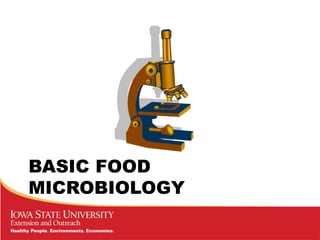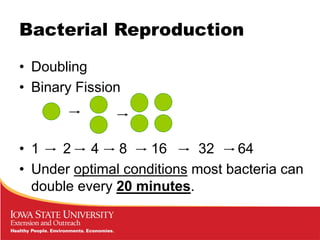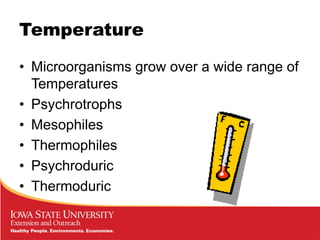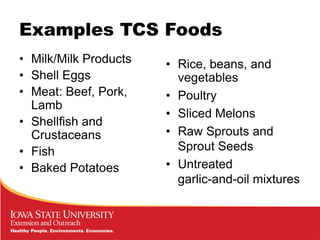Basic-Microbiology1
- 2. Bacteria Microbiology âĒ Microscopic âĒ Single Cell âĒ Shape â Cocci- Spherical* â Bacilli â Rod * â Sperilli â Corkscrew, Comma âĒ *Most Food Borne Pathogens are Cocci or Rod shape
- 3. Bacterial Reproduction âĒ Doubling âĒ Binary Fission âĒ 1 2 4 8 16 32 64 âĒ Under optimal conditions most bacteria can double every 20 minutes.
- 4. Growth Curve Phases âĒ Lag â Bacteria adapting to environment âĒ Log â Logarithmic growth reproduce to high numbers in short period of time âĒ Stationary â Death=Growth âĒ Death â Sharp decline in numbers â Ran out of Nutrients â Accumulation of waste â Accumulation of toxin Objective - Extend the Lag Phase
- 6. Spores vs Vegetative âĒ Vegetative Cells â Living cells, metabolically active (ingest nutrients, secrete waste) âĒ Spores â Endospore â Function â Protection from the environment â Dormant cell â no intake of nutrients, not secreting waste â Resistant to Heat, Cold, Chemicals, Radiation
- 7. What Microorganisms Need to Grow âĒ Acronym â FAT TOM â F â Food â A â Acidity â T â Temperature â T â Time â O â Oxygen â M â Moisture
- 8. Intrinsic Factors âĒ Intrinsic â pH â Moisture Content â Oxygen Needs â Nutrient Content â Antimicrobial Constituents â Biological Structures
- 9. pH âĒ Effects of pH â Enzymes â Nutrients âĒ Other Environmental Factors â Temperature â Salt â Age âĒ No known pathogen grows below pH of 4.6 â Clostridium botulinum
- 10. Moisture âĒ Remove and/or Bind Moisture â Humectants â Dehydration âĒ Water Activity â Aw âĒ Most Fresh Foods - Aw > 0.99 0 1 Pure waterNo water
- 11. Microbial Growth and Aw âĒ Halophilic 0.75 âĒ Xerophilic molds 0.61 âĒ Osmophilic yeasts 0.61 âĒ Lowest Aw for Pathogen Growth â 0.86 â Stapholococcus aureus
- 12. Oxygen Conditions âĒ Aerobic â Requires air to grow and multiple âĒ Anaerobic â Requires no air to grow and multiple âĒ Microaerobic â Requires an atmosphere less than air âĒ Facultative anaerobes â can live in the absence as well as in the presence of atmospheric oxygen
- 13. Others Factors âĒ Nutrients â Fastidius vs non-fastidious â unusual and/or complex nutritional needs and must be grown on enriched media. âĒ Biological Structure âĒ Antimicrobial Factors â Naturally occurring factors
- 14. Extrinsic Factors âĒ Temperature âĒ Relative Humidity âĒ Gases in the Environment âĒ Presence of Other Microorganisms
- 15. Temperature âĒ Microorganisms grow over a wide range of Temperatures âĒ Psychrotrophs âĒ Mesophiles âĒ Thermophiles âĒ Psychroduric âĒ Thermoduric
- 16. Other Factors âĒ Relative Humidity of Environment â Can change the Aw âĒ Environmental Gasses â CO2, Ozone, modified atmosphere packaging
- 17. Temperature Control for Safety Foods (TCS) âĒ High Moisture (H2O) â AW > 0.85 â AW â Water Activity â water available in a food for microbial growth and chemical reactions âĒ pH > 4.6 âĒ High Protein âĒ High Starch
- 18. Examples TCS Foods âĒ Milk/Milk Products âĒ Shell Eggs âĒ Meat: Beef, Pork, Lamb âĒ Shellfish and Crustaceans âĒ Fish âĒ Baked Potatoes âĒ Rice, beans, and vegetables âĒ Poultry âĒ Sliced Melons âĒ Raw Sprouts and Sprout Seeds âĒ Untreated garlic-and-oil mixtures
- 19. Types of Illness âĒ Foodborne illness â Illness carried or transmitted to people by food. âĒ Foodborne Infections â result of a person eating food containing pathogens, which then grow in the intestines and cause illness. â typically symptoms of foodborne illness do not appear immediately
- 20. Types of Illness âĒ Foodborne intoxication â Result of a person eating food containing toxins (poisons) that cause an illness. The toxins my have been produced by pathogens found on the food or may be result of a chemical contamination, or part of the natural food. â Appear quickly, within a few hours.
- 21. Types of Illness âĒ Foodborne Toxin-mediated infection â Result of a person eating food containing pathogens which then produce illness-causing â toxins in the intestines. âĒ Gastrointestinal illness â Illness relating to the stomach or intestine
- 22. Questions






















